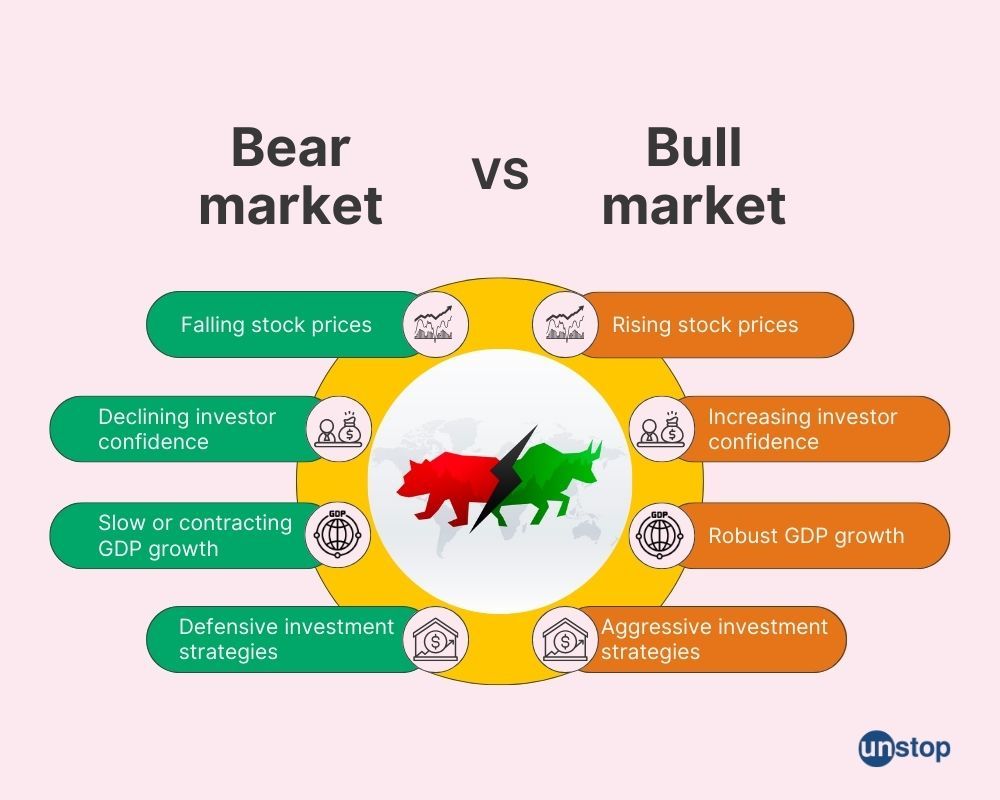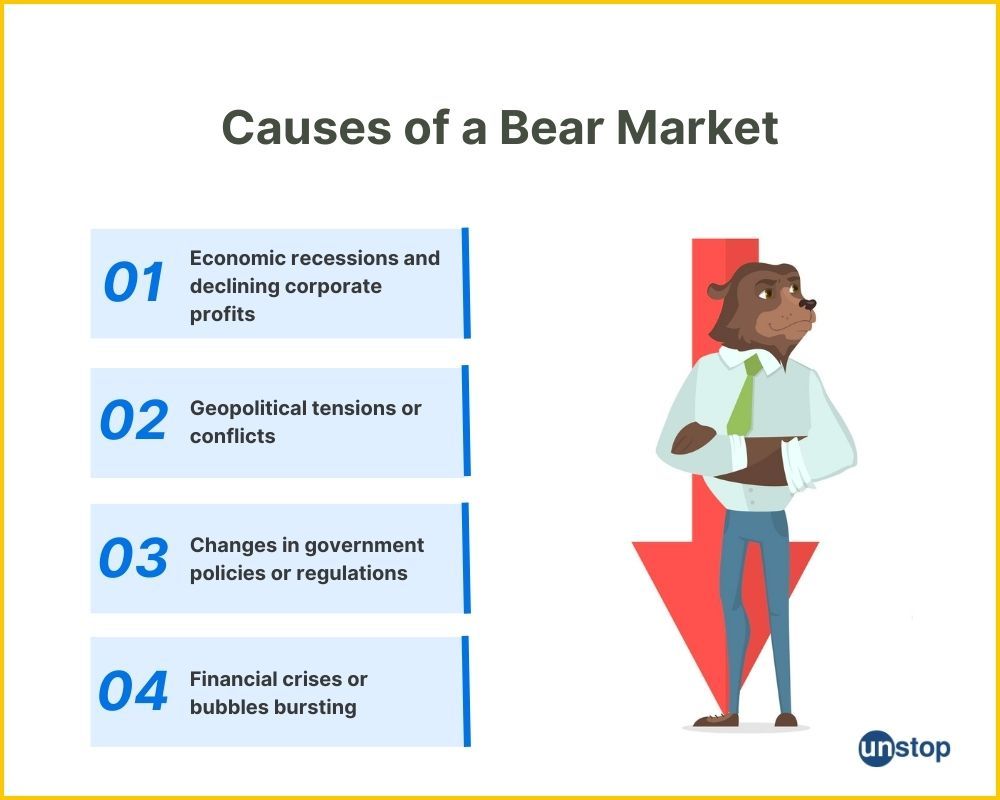- What is a Bear Market?: Understanding Its Phases
- Bear Market vs. Bull Market
- Causes of Bear Markets: Analyzing the Triggers
- Examples of Bear Markets: Historical Cases Explored
- Investing Strategies During Bear Markets
- Long-Term Investing in Bear Markets: Key Considerations
- Frequently Asked Questions (FAQs)
What Is A Bear Market?: A Detailed Guide To Navigating It Along With Investing Tips

Have you ever heard the term "bear market" thrown around in financial discussions? If you're not quite sure what is a bear market, don't worry; you're not alone. Many people find the concept of a bear market a bit perplexing. But fear not because today we're going to dive into the world of bear markets and demystify this term for you.
So, what is a bear market exactly?
In simple terms, it refers to a period of time when stock prices experience a significant decline. This downward trend can last for months or even years, and it often creates a sense of fear and uncertainty among investors.
Still confused about what is a bear market? Let's dive into this detailed guide to understand the ins and outs of navigating a bear market and gain some valuable investing tips along the way.
Looking for investing tips as a young professional? Here's the advice Zerodha co-founder Nikhil Kamath has for young professionals interested in saving and investing.
What is a Bear Market?: Understanding Its Phases

Bear markets can be a rollercoaster of emotions for investors. They are characterized by a prolonged period of declining stock prices, pessimism, and widespread selling. The average duration of bear markets can vary, but they typically last around 14-18 months. However, it is important to note that they can sometimes be shorter or longer.
Let's delve into the three phases that make up a bear market: the distribution phase, the panic phase, and the capitulation phase.
Distribution Phase
In the distribution phase, things start to go south. Buying interest dwindles while selling pressure increases. It's like a party where fewer people are showing up, but more people want to leave. Investors become cautious as they sense that the market may be reaching its peak. This is when smart investors begin to sell their stocks before the real trouble hits.
Panic Phase
When the panic phase sets in, fear takes over the market. Investors start rushing to sell their stocks out of pure dread and negative sentiment. It's like everyone suddenly realizes there's a fire in the building, and they all scramble for the exits at once. The rapid selling leads to further price declines as supply outweighs demand.
Capitulation Phase
The capitulation phase is where things get messy. Selling reaches its peak during this stage, causing prices to plummet even further. It's like a scene from an action movie where everything explodes and collapses around you. Many investors throw in the towel at this point, believing that it's hopeless to continue holding onto their investments.
The capitulation phase often marks a potential bottoming out of the market, as extreme fear tends to precede opportunities for recovery and growth.
Bear Market vs. Bull Market: Understanding the Difference

In the world of investing, there are two terms that you may have come across: bear market and bull market. These terms describe the overall direction of the stock market and can have a significant impact on investor sentiment and decision-making.
Here’s a quick look at how the two differ:
| Criteria | Bear Market | Bull Market |
|---|---|---|
| Price of stocks | Falling stock prices | Rising stock prices |
| Investor Sentiment | Pessimism among investors and declining investor confidence | Optimism among investors and increasing investor confidence |
| Economic Conditions | Negative economic news | Positive economic news |
| GDP Growth | Slow or contracting GDP growth | Robust GDP growth |
| Unemployment Rate | Rising unemployment rates | Low unemployment rates |
| Investment strategies | Diversification of portfolios and defensive strategies like investing in bonds, etc. | Aggressive strategies like day trading and investing in high-growth stocks. |
Bear Market vs Bull Market: Which is a better time to invest in stocks?
When it comes to investing in stocks, determining the ideal time can be a challenging task. The decision of whether to invest in stocks during a bear market or a bull market depends on an individual's investment goals, risk tolerance, and time horizon.
While a bear market may offer attractive buying opportunities for long-term investors seeking to capitalize on undervalued stocks, a bull market may be more suitable for short-term traders looking to take advantage of upward price trends. It is crucial to conduct thorough research, diversify investments, and consult with financial professionals before making any investment decisions.
Know what it takes to make a career as a stockbroker in this handy guide.
Causes of Bear Markets: Analyzing the Triggers

Bear markets can be a real downer for investors, but understanding the factors that contribute to their occurrence can help us navigate the stormy waters:
Economic recessions often trigger bear markets due to declining corporate profits.
When the economy takes a downturn and enters a recession, it can have a significant impact on corporate profits. During these periods, consumers tend to tighten their wallets, leading to decreased spending and lower revenues for businesses. As a result, stock prices decline, causing investors to sell off their holdings and triggering a bear market.
Geopolitical tensions or conflicts can lead to increased uncertainty in financial markets.
Political instability or conflicts between nations can create an atmosphere of uncertainty in financial markets. Investors become cautious as they fear potential disruptions to global trade or economic policies. This uncertainty often leads them to sell their investments, pushing stock prices down and contributing to a bear market.
Changes in government policies or regulations may negatively impact specific industries or sectors.
When governments implement new policies or regulations that affect specific industries or sectors, it can have ripple effects on the overall market. For example, stricter environmental regulations could hurt companies in the fossil fuel industry while benefiting renewable energy companies. These changes create uncertainties for investors who may choose to sell their stocks, resulting in a bear market for those affected industries.
Financial crises or bubbles bursting
Financial crises occur when there is widespread panic and loss of confidence in the financial system. This loss of confidence leads investors to withdraw their funds from various investment vehicles such as stocks and bonds. When speculative bubbles burst (such as the dot-com bubble in 2000), it causes stock prices to plummet rapidly, triggering a bear market.
By keeping a close eye on economic indicators, geopolitical events, government policies, and financial stability, investors can make informed decisions to protect their investments.
Examples of Bear Markets: Historical Cases Explored
Here’s a look at some of the most significant historical cases of a bear market:
The Great Depression (1929–1932)
The Great Depression stands as one of the most severe bear markets in history. It was triggered by the stock market crash in 1929, which led to a massive decline in stock prices. As a result, investors faced significant losses, businesses struggled, and unemployment rates soared.
The Dotcom Bubble (2000–2002)
Another example is the Dotcom Bubble, which occurred in the early 2000s. This period saw an explosion of internet-based companies and technology stocks reaching unprecedented valuations. However, this bubble eventually burst, resulting in a sharp decline in technology stocks' value. Many companies went bankrupt or experienced substantial losses.
The Global Financial Crisis (2007–2009)
The Global Financial Crisis was another major bear market that had far-reaching consequences worldwide. It began with the collapse of Lehman Brothers and spread throughout the financial system. This crisis led to a severe recession and caused stock markets around the world to plummet.
The COVID-19 Pandemic (2020)
Most recently, we witnessed a rapid bear market due to the global economic uncertainty brought on by the COVID-19 pandemic. As countries implemented lockdowns and businesses shut down temporarily, investor confidence dwindled rapidly. Stock markets experienced steep declines as fears about economic stability grew.
Bear markets can be challenging for investors as they often involve substantial declines in stock prices over an extended period. Understanding historical examples helps us grasp how these downturns can impact economies and individuals alike.
Investing Strategies During Bear Markets
It’s a common misconception that you can’t invest during a bear market. Here are some key investment strategies to consider during a bear market:
Diversification is Key
Diversification is the practice of spreading your investments across different asset classes, such as stocks, bonds, and commodities. This helps minimize risk by not putting all your eggs in one basket. By diversifying, you can potentially offset losses in one area with gains in another.
Defensive Stocks Perform Better
Defensive stocks are those that tend to hold up better during bear markets. These companies operate in sectors like healthcare or consumer goods, which are less affected by economic downturns. Investing in defensive stocks can provide stability and potential returns when other sectors may be struggling.
Value Investing for Long-Term Growth
Value investing involves identifying undervalued stocks with strong fundamentals. During bear markets, many quality companies may experience temporary price declines. By focusing on these opportunities and investing for the long term, you can potentially benefit from their eventual recovery and growth.
Dollar-Cost Averaging Strategy
Dollar-cost averaging is an investment strategy where you consistently invest a fixed amount of money at regular intervals regardless of market conditions. This approach allows you to buy more shares when prices are low and fewer shares when prices are high. Over time, this can help smooth out the impact of market volatility on your overall investment performance.
Consider Inverse ETFs
Inverse exchange-traded funds (ETFs) are designed to perform inversely to a specific index or sector. These instruments can be used as a hedging tool during bear markets as they aim to profit from declining markets. However, it's important to note that inverse ETFs come with their own risks and complexities, so thorough research is necessary before considering them as part of your investment strategy.
By implementing these strategies, you can position yourself to navigate bear markets more effectively and potentially even capitalize on opportunities that arise during market downturns.
Long-Term Investing in Bear Markets: Key Considerations
Bear markets can be intimidating, but they also present opportunities for long-term investors who are looking to snag discounted stocks. It's important to approach these periods with patience and discipline, as sustained market declines can test even the most seasoned investors.
Regularly reviewing and rebalancing your investment portfolio is crucial during bear markets. This practice helps you maintain a long-term perspective and ensures that your investments align with your financial goals. By rebalancing, you can take advantage of lower stock prices by buying more shares or reallocating funds to areas that may have been hit harder.
Understanding the historical recovery patterns is another key consideration for long-term investors. While past performance does not guarantee future results, studying how previous bear markets have played out can provide valuable insights. For example, some bear markets have experienced sharp recoveries followed by sustained periods of growth, while others have had more prolonged recoveries.
Investor sentiment plays a significant role in bear markets. During times of market decline, fear and panic can drive investors to sell their securities at low prices, resulting in losses. However, it's important to remember that successful investing requires a level-headed approach. By staying focused on your long-term goals and avoiding knee-jerk reactions based on short-term fluctuations, you increase your chances of weathering the storm and potentially benefiting from the eventual market rebound.
Conclusion
Navigating bear markets successfully requires continuous learning and adaptation. Staying informed about market trends, seeking professional advice when needed, adopting a proactive approach, and tailoring investment strategies tailored to your goals can provide growth potential.
Frequently Asked Questions (FAQs)
1. How long do bear markets typically last?
Bear market durations can vary significantly depending on various factors such as economic conditions, market sentiment, and government interventions. On average, they tend to last around 14-18 months.
2. Should I sell all my investments during a bear market?
Selling all your investments during a bear market may not be advisable unless it aligns with your financial goals or risk tolerance. It's essential to have a well-diversified portfolio that considers both short-term needs and long-term objectives.
3. Are there any sectors that perform well during bear markets?
Certain sectors like consumer staples (e.g., food & beverages), healthcare, utilities, or companies with stable cash flows tend to perform relatively better during bear markets due to their defensive nature.
4. Can bear markets present investment opportunities?
Yes, bear markets can present investment opportunities for those who are well-prepared. It's crucial to conduct thorough research and identify undervalued assets or sectors that have the potential for recovery in the long run.
5. How can I protect my investments during a bear market?
To protect your investments during a bear market, consider diversifying your portfolio, focusing on high-quality assets, setting stop-loss orders, and regularly reviewing your investment strategy with a financial advisor.
Suggested Reads:
- What is A Free Market: Meaning, Benefits And Disadvantages
- The Difference Between Wholesale And Retail Explained (With Examples)
- Retail Marketing: Types, Strategies And Examples Of Successful Market Players!
- Brand Awareness A To Z: Comprehensive Guide For New Businesses
- Brand Identity: A Definitive Guide For Understanding This Marketing Concept
I’m a reader first and a writer second, constantly diving into the world of content. If I’m not writing or reading, I like watching movies and dreaming of a life by the beach.
Login to continue reading
And access exclusive content, personalized recommendations, and career-boosting opportunities.
Subscribe
to our newsletter
















Comments
Add comment